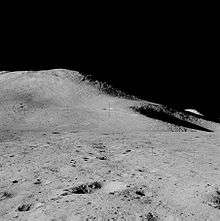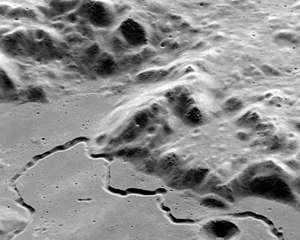Mons Hadley Delta
Mons Hadley Delta (δ) is a massif in the northern portion of the Montes Apenninus, a range in the northern hemisphere of the Moon adjacent to Mare Imbrium. It has a height of 3.6 km above the plains to the north and west.

| Mons Hadley Delta | |
|---|---|
 Mons Hadley Delta from orbit, facing east, with the Apollo 15 landing site at left | |
| Highest point | |
| Elevation | 8789 m (summit)[1] |
| Listing | Lunar mountains |
| Coordinates | 25.72°N 3.71°E[2] |
| Geography | |
| Location | the Moon |
To the north of this mountain is a valley that served as the landing site for the Apollo 15 expedition. To the northeast of this same valley is the slightly larger Mons Hadley peak with a height of about 4.6 km. To the west of these peaks is the sinuous Rima Hadley rille.
These features were named after John Hadley.[3]
On the Apollo 15 mission in 1971, the astronauts David Scott and James Irwin explored the lower reaches of the north slope of Mons Hadley Delta, and collected many samples which were returned to earth. Station 2 was near St. George crater, and Stations 6, 6A, and 7 were at or near Spur crater. They found the famous "Genesis Rock", sample 15415, at Spur. A clast of anorthosite within this rock is likely to be a piece of the primordial lunar crust.
References
- LTO-41B4 Hadley — L&PI Lunar Topographic Orthophotomap
- "Mons Hadley Delta". Gazetteer of Planetary Nomenclature. USGS Astrogeology Research Program.
- "Mons Hadley". Gazetteer of Planetary Nomenclature. USGS Astrogeology Research Program.
- Andersson, L. E.; Whitaker, E. A. (1982). NASA Catalogue of Lunar Nomenclature. NASA RP-1097.CS1 maint: ref=harv (link)
- Bussey, B.; Spudis, P. (2004). The Clementine Atlas of the Moon. New York: Cambridge University Press. ISBN 978-0-521-81528-4.CS1 maint: ref=harv (link)
- Cocks, Elijah E.; Cocks, Josiah C. (1995). Who's Who on the Moon: A Biographical Dictionary of Lunar Nomenclature. Tudor Publishers. ISBN 978-0-936389-27-1.CS1 maint: ref=harv (link)
- McDowell, Jonathan (July 15, 2007). "Lunar Nomenclature". Jonathan's Space Report. Retrieved 2007-10-24.CS1 maint: ref=harv (link)
- Menzel, D. H.; Minnaert, M.; Levin, B.; Dollfus, A.; Bell, B. (1971). "Report on Lunar Nomenclature by the Working Group of Commission 17 of the IAU". Space Science Reviews. 12 (2): 136–186. Bibcode:1971SSRv...12..136M. doi:10.1007/BF00171763.CS1 maint: ref=harv (link)
- Moore, Patrick (2001). On the Moon. Sterling Publishing Co. ISBN 978-0-304-35469-6.CS1 maint: ref=harv (link)
- Price, Fred W. (1988). The Moon Observer's Handbook. Cambridge University Press. ISBN 978-0-521-33500-3.CS1 maint: ref=harv (link)
- Rükl, Antonín (1990). Atlas of the Moon. Kalmbach Books. ISBN 978-0-913135-17-4.CS1 maint: ref=harv (link)
- Webb, Rev. T. W. (1962). Celestial Objects for Common Telescopes (6th revision ed.). Dover. ISBN 978-0-486-20917-3.CS1 maint: ref=harv (link)
- Whitaker, Ewen A. (1999). Mapping and Naming the Moon. Cambridge University Press. ISBN 978-0-521-62248-6.CS1 maint: ref=harv (link)
- Wlasuk, Peter T. (2000). Observing the Moon. Springer. ISBN 978-1-85233-193-1.CS1 maint: ref=harv (link)
External links
| Wikimedia Commons has media related to Mons Hadley Delta. |
- LTO-41B4 Hadley — L&PI Lunar Topographic Orthophotomap